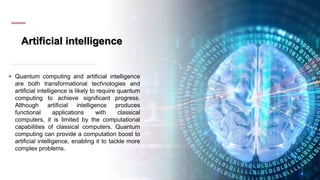Aditya kulshreshtha, (QUANTUM COMPUTING)
- 2. CONTENTS • Introduction • History • Concepts of Quantum computing Qubits Quantum Information Quantum Superposition Quantum Entanglement Quantum Teleportation Quantum Parallelism
- 3. • Applications Quantum networking Ultra secure communications Artificial intelligence Molecular simulations • Why quantum computers? • Current challenges • Conclusion CONTENTS
- 4. Introduction • Quantum computing is a modern approach of computing that is based on the science of quantum mechanics (A branch of physics that explores physical world at most fundamental level). At this level particle behave differently from classical world taking more than one state at the same time and interacting with other particles that are very far away. • Quantum computing is a beautiful combination of physics, mathematics, computer science and information theory.
- 5. History Feynman proposed the idea of creating machines based on the laws of quantum mechanics instead of the laws of classical physics. 1982 David Deutsch developed the Quantum Turing Machine, showing that quantum circuits are universal. 1985 Peter Shor came up with a quantum algorithm to factor very large numbers in polynomial time. 1994 Grover’s came up with an algorithm to search a name in unsorted database. 1996
- 6. Concepts of Quantum Computing • Quantum computing focuses on the principles of quantum theory, which deals with modern physics that explain the behavior of matter and energy of an atomic and subatomic level. • Quantum computing makes use of quantum phenomena, such as Qubits, Quantum superposition, and Quantum entanglement, Quantum teleportation, etc. to perform data operations.
- 7. Qubits • Qubits stands for Quantum Bits and these are the units of quantum information. • In classical computing the information is encoded in bits, where each bit can have the value zero or one. Whereas, In quantum computing the information is encoded in qubits. • Many different physical objects can be used as qubits such as atoms, photons, or electrons.
- 8. Quantum information • Quantum information is physical information that is held in the “state” of a quantum system. • the amount of information that can be retrieved in a single qubit is equal to one bit, the difference lies in the processing of information.
- 9. Quantum superposition • According to Louis de-Broglie- In classical physics, An electron has dual nature, it can exhibit as a particle and as a wave. • Wave exhibits a phenomenon known as superposition of waves and This phenomena allows the addition of waves numerically.
- 10. • Similarly, a quantum state in superposition can be seen as a linear combination of other distinct quantum states. This quantum state in superposition forms a new valid quantum state • Superpositions occur all the time at the quantum level. i.e., any quantum object like an electron or photon is in superposition CONTI…...
- 11. Quantum entanglement • In Quantum Mechanics, it sometimes occurs that a measurement of one particle will affect the state of another particle, even though classically there is no direct interaction, is known as quantum entanglement. • When this happens, the state of the two particles is said to be entangled.
- 12. Quantum Teleportation • Quantum teleportation is a technique used to transfer information on a quantum level, usually from one particle to another. • Its distinguishing feature is that it can transmit the information present in a quantum superposition, useful for quantum communication and computation. SOURCE- Marxtech Digital Solutions
- 13. Quantum Parallelism • It is the method in which a quantum computer is able to perform two or more computations simultaneously. • In classical computers, parallel computing is performed by having several processors linked together.
- 14. • In a quantum computer, a single quantum processor is able to perform multiple computations on its own. • Parallelism allows a quantum computer to work on many computation at once. • Quantum computers have a peculiar group of bits called qubits that can represent all possible points simultaneously. CONTI……
- 15. Applications • Quantum computing is the exploitation of collective properties of quantum states, such as superposition and entanglement, to perform computation. • The devices that perform quantum computations are known as quantum computers. They are believed to be able to solve certain computational problems, such as integer factorization which is substantially faster than classical computers.
- 16. Quantum networking • One possible use of quantum computers is that of networking, both intranet and internet. • Quantum teleportation using light beams may be able to carry a great deal more information, enough perhaps to support practical computing. • But the issue in this is, creating large enough beams of light in both locations, sending and receiving, to send all of the data within a reasonable amount of time.
- 17. Ultra secure communications • It is possible to transmit information without a signal path by using quantum teleportation. There is no way to intercept the path and extract information. • Ultra-secure communication is also possible by super- dense information coding where quantum bits can be used to allow more information to be communicated per bit than the same number of classical bits.
- 18. Artificial intelligence • Quantum computing and artificial intelligence are both transformational technologies and artificial intelligence is likely to require quantum computing to achieve significant progress. Although artificial intelligence produces functional applications with classical computers, it is limited by the computational capabilities of classical computers. Quantum computing can provide a computation boost to artificial intelligence, enabling it to tackle more complex problems.
- 19. Molecular simulations • A quantum computer can simulate physical processes of quantum effects in real time. • Molecular simulations of chemical interactions or chemical reactions. • Allows chemists and pharmacists to learn more about how their products interact with each other, and with biological processes. Ex: How a drug may interact with a person’s metabolism or disease.
- 20. Why Quantum computers? • Quantum computers work on an atomic level, which is roughly 200 times smaller than Intel’s brand new 45nm architecture. • Would be very useful in research and algorithm computation
- 21. Current challenges 1. Number of bits in a word- 12-qubit machines is the most advanced to date. Difficulty with large words is, too much quantum interaction can produce undesired results. Since all the atoms interact with each other. 2. Physical size of the machines- Current machines are too large to be of practical use to everyday society. If these drawbacks could be overcome and if scientists could control even 50 atoms, researchers claim that the computing power of that computer would be more than the current supercomputers.
- 22. Conclusion • Quantum computers have the potential to revolutionize computation by making certain types of classically intractable problems solvable. While no quantum computer is yet sophisticated enough to carry out calculations that a classical computer can't, great progress is under way.
- 23. REFERENCES • https://marxtechdigitalsolutions.com/blog/2019/04/09/quantum-teleportation/ • https://www.ibm.com/quantum-computing/what-is-quantum-computing/ • https://www.ncbi.nlm.nih.gov • https://en.wikipedia.org/wiki/ • https://www.technologyreview.com/ • https://www.wilsoncenter.org/
- 24. THANK YOU!























